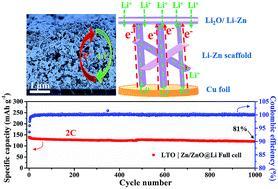我室彭栋梁教授在 Journal of materials chemistry A 上发表论文: Electrochemically induced highly ion conductive porous scaffolds to stabilize lithium deposition for lithium metal anodes
文章链接:https://pubs.rsc.org/en/content/articlelanding/2019/ta/c9ta01834d#!divAbstract
摘要:
Lithium (Li) metal is regarded as one of the most promising anode candidates for next-generation energy storage systems due to its high theoretical capacity and low operating voltage. However, the growth of lithium dendrites caused by inhomogeneous and uncontrolled Li deposition hinders its practical application. Herein, a 3D porous lithiophilic zinc (Zn) scaffold modified with a thin zinc oxide (ZnO) surface layer on Cu foil (Zn/ZnO/Cu) as a current collector for lithium metal anodes is constructed by magnetron sputtering. The Zn/ZnO scaffold would react with Li+ ions before the deposition of lithium metal, leading to the formation of a Li–Zn alloy scaffold with a Li2O modified layer (Li–Zn/Li2O) on its surface. The surface Li2O layer with high ionic conductivity would passivate the conductive surface and provide a potential gradient across the surface layer and 3D porous Li–Zn alloy scaffold. Consequently, a Zn/ZnO@Li|Li symmetric cell can cycle stably for more than 500 h at 4 mA cm−2 for a total capacity of 1 mA h cm−2 and a low polarization (around 40 mV). Moreover, an ultra-long cycling life with a high capacity retention of 81% after 1000 cycles for a Li4Ti5O12|Zn/ZnO@Li full cell is also realized, showing that the Li–Zn/Li2O porous scaffold on Cu foil has a great prospect as a 3D current collector for Li metal anodes in the future.
